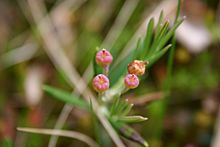Beacon Bog facts for kids
| Site of Special Scientific Interest | |

Bog rosemary
|
|
| Area of Search | Carmarthen & Dinefwr |
|---|---|
| Coordinates | 51°49′30″N 4°23′21″W / 51.8251°N 4.3891°W |
| Interest | Biological |
| Area | 11.5 hectares (28 acres) |
| Notification | 1973 |
Beacon Bog is a very special natural area in Llangynog, Carmarthenshire, Wales. It is known as a Site of Special Scientific Interest (SSSI). This means it's a protected place because it has unique plants and habitats.
Contents
What is Beacon Bog?
Beacon Bog is a type of wetland called a raised bog. It covers about 11.5 hectares (28 acres) of land. In the middle, the ground is made of deep peat, which can be up to 2 metres (6.6 ft) thick! This special bog is home to many rare plants. It is located about 7 kilometres (4.3 mi) southwest of Carmarthen. This important site was first protected in 1973.
Why is Beacon Bog Important?
Beacon Bog is very important because it has a special type of wetland called a raised bog. But it's not just a bog! The site also has other natural areas. These different habitats help many kinds of plants and animals live there. You can find a wide variety of flowers, mosses, ferns, insects, and even fungi. This mix of life makes Beacon Bog a truly unique place.
Habitats and Wildlife at Beacon Bog
Beacon Bog has several different natural areas. Besides the wet bog, you can find areas with bushes (scrub), natural woodlands, marshy grasslands, and standing water.
Plants of the Bog
The wet surface of the bog is perfect for bog mosses (Sphagnum spp.) to grow. These mosses are very important for the bog's health. Some rare plants found here include the beautiful bog rosemary (Andromeda polifolia), the large royal fern (Osmunda regalis), and the tasty cranberry (Vaccinium oxycoccus).
Plants of the Edges
On the drier western side of the bog, you might see petty whin (Genista anglica). The edges of the site are mostly covered by purple moor-grass (Molinia caerulea).
Rare Insects
Beacon Bog is also home to a very rare insect. A special type of weevil called Bagous frit has been found living here.
Looking After Beacon Bog
Managing a special site like Beacon Bog means making sure it stays healthy. This involves controlling activities that might harm it. It also means planning changes to make the site even better. And it includes dealing with problems like plants that don't belong there.
Planning for the Future
Experts at Natural Resources Wales have plans for Beacon Bog. They want the raised bog to cover about 65% of the site. Marshy grassland should make up about 15%. Bushes and woodlands would be limited to 20%. They want native trees like willow to grow in the woodland. Dead wood is also important, as it provides homes for birds, insects, and fungi. The plan also aims to help the rare Bagous frit weevil and the black bog ant thrive.
Challenges and Solutions
Keeping the right water levels is key to protecting Beacon Bog. Drainage on nearby farms might have already affected the bog's water. No new drainage should be built, and existing drainage needs to be watched carefully.
Bushes are growing into the bog, which can be a problem. These bushes need to be monitored and cut back when necessary. Another issue is rhododendron, a plant that can take over and push out native species. It should be removed by hand, and the site needs regular checks for new plants. In the past, Beacon Bog was often burned. However, we now know that burning harms insects, so this practice has stopped.

